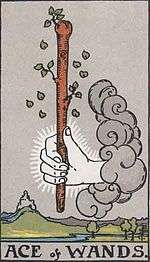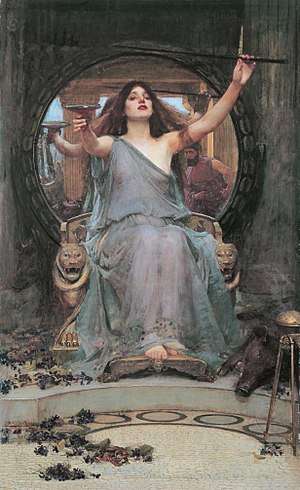Wand
A wand is a thin, light-weight rod that is held with one hand, and is traditionally made of wood, but may also be made of other materials, such as metal or plastic. A wand that is used for magical purposes is often called a magic wand, rather than simply a wand. Wands are distinct from scepters, which have a greater thickness, are held differently, and have a relatively large top ornament on them.
In modern times, wands are usually associated with stage magic or supernatural magic, but there have been other uses, all stemming from the original meaning as a synonym of rod and virge. A stick that is used for reaching, pointing, drawing in the dirt, and directing other people, is one of the earliest and simplest of tools.
Status symbolism
In British formal government ceremony, special officials may carry a wand of office that represents their power. Compare in this context the function of the ceremonial mace, the scepter, and the staff of office. Its age may be even greater, as Stone Age cave paintings show figures holding sticks, which may be symbolic representations of their power.[1]
Mystical and religious usage

Wands are used in The Hermetic Order of the Golden Dawn, Thelema, and Wicca, and by independent practitioners of magic.
Wands were introduced into the occult via the 1200s Latin grimoire The Oathbound Book of Honorius. The wand idea from the Book of Honorius, along with various other ideas from that grimoire, were later incorporated into the 1500s grimoire The Key of Solomon. The Key of Solomon became popular among occultists for hundreds of years. In 1888, there was the publication of an English translation of the Key of Solomon by Samuel Mathers (one of the co-founders of the Hermetic Order of the Golden Dawn), which made the text of the Key of Solomon available to the anglophone world. That 1888 English version inspired Gerald Gardner, the creator of Wicca, to incorporate the wand and various other ritual objects into Wicca.
The creators of the Golden Dawn got their idea to use a wand, as well as their other main ritual objects (dagger, sword, hexagrammic pentacle, and cup), from the writings of the mid-1800s occultist author Eliphas Levi. Levi himself mentioned most of those objects (all except for the cup) in his writings because they are in the Key of Solomon, whereas he got the cup from the tarot suit of cups. In Levi's 1862 book Philosophie Occulte, he wrote a fake excerpt of a Hebrew version of the Key of Solomon, and that fake excerpt was part of the inspiration for the Golden Dawn's ritual objects, and especially their lotus wand.
The ceremonial magic of the Hermetic Order of the Golden Dawn uses several different types of wands for different purposes, the most prominent of which are the fire wand and the lotus wand. In Wicca, wands are traditionally used to summon and control angels and genies,[2][3] but have later come to also be used for general spell-casting. Wands serve a similar purpose to athames (ritual daggers), though the two objects have their distinct uses: An athame is used to command, whereas a wand is seen as more gentle, and is used to invite or encourage.
Wands are traditionally made of wood— practitioners usually prune a branch from an oak, hazel, or other tree, or may even buy wood from a hardware store, and then carve it and add decorations to personalize it, though one can also purchase ready-made wands. In Wicca, the wand usually represents the element air,[4][5] or sometimes fire (following the wiccan author Raymond Buckland, who got his element associations from the Golden Dawn), although contemporary wand-makers also create wands for the elements of earth and water.
Tarot cards
The suit of wands is one of the four suits in the 1909 Rider-Waite-Smith occult tarot deck, and other, later tarot decks that are based upon that deck. The suit of wands replaced the suit of batons from earlier, non-occult tarot decks. The Rider-Waite-Smith tarot deck also replaced the suit of coins from earlier, non-occult decks, with the suit of pentacles. The Rider-Waite-Smith tarot deck was designed by two members of the Hermetic Order of the Golden Dawn- Arthur Edward Waite and Pamela Colman Smith. Waite provided the general guidelines for the deck (including the names of the four suits, and thus the suit of wands), and detailed guidelines for the designs of the major arcana, and he hired Smith to do the painting, and to make original artwork for the minor arcana. Waite instructed Smith to not paint actual wands in the wand cards, but rather to paint large tree trunk staffs with some foliage growing on them, so as to make an association between wands and Eliphas Levi's phrase "the flowering rod of Aaron" from Levi's fake fragment of The Key of Solomon.
Fiction

The concept of magic wands was used by the ancient greek writer Homer, in his books The Iliad and The Odyssey. In all cases, Homer used the word 'rabdos', which means 'rod', and implies something that is thicker than the modern conception of wands. In those books, Homer wrote that magic wands were used by three different gods, namely Hermes, Athena, and Circe. In The Iliad, Homer wrote that Hermes generally used his magic wand to make people sleep and wake up. In The Odyssey, Homer wrote that Athena used her magic wand to make Odysseus old, and then young again, and that Circe used her magic wand to turn Odysseus's men into pigs.
Italian fairy tales put wands into the hands of the powerful fairies by the late Middle Ages.[6]
In the 1700s ballads "Allison Gross" and "The Laily Worm and the Machrel of the Sea", the villainesses use silver wands to transform their victims into animals, in emulation of the Odyssey that preceded them.[7] In C. S. Lewis's 1950 novel The Lion, the Witch and the Wardrobe, the White Witch's most feared weapon is her wand, whose magic is capable of turning people into stone. This, again, employs the Odysseyan motif of an evil female witch who uses a magic wand to maliciously transform her victims.
In the mid 1900s, the MGM and Disney media companies popularized magic wands via four films in which wands were wielded by benevolent female fairy characters. Those movies were The Wizard of Oz (1939; MGM; a wand-staff was wielded by Glinda the Good Witch of the North), Pinocchio (1940; Disney; a wand was wielded by "the blue fairy"), Cinderella (1950; Disney; a wand was wielded by a "fairy godmother"), and Sleeping Beauty (1959; Disney; a wand was wielded by each of three fairies). In The Wizard of Oz and Pinocchio, the fairies' wands are embellished with a star-shaped ornament on the end, whereas in Cinderella and Sleeping Beauty, the fairies have wands with traditional plain tips.
Magic wands commonly feature in works of fantasy fiction as spell-casting tools. Few other common denominators exist, so the capabilities of wands vary wildly. In Joanne K. Rowling's Harry Potter series, the first book of which was published in 1997, personal wands are common, as necessary tools to channel out each character's magic, and they are used as weapons in magical duels, and it is the wand that chooses its owner. A wand is also present in the Children of the Red King series in the possession of Charlie Bone as well as the popular MMORPG World of Warcraft where caster classes such as the mage and warlock use wands offensively.
Non-magical usage
- In music, the term sometimes applies to the modern model of conductor's baton (the earlier staff and baton cantoral being heavier and thus unfit for precise gestures).
- In literary language, "wand" can be a synonym for rod as an implement for corporal punishment, in the generic sense: either a multiple rod or a single branch (switch or cane), but not a specific physical type.
- Based on their magical symbolism, stage magicians often use "magic wands" as part of their misdirection.[8] These wands are traditionally short and black, with white tips. A magic wand may be transformed into other items, grow, vanish, move, display a will of its own, or behave magically in its own right. A classic magic trick makes a bouquet of flowers shoot out of the wand's tip.
- A lacrosse stick is colloquially referred to as a "wand."
- "To wand" is a colloquial verb that means to check something with a handheld metal detector, such as at the airport and high security buildings.[9]
- Wooden wands of about 60" in length were popular exercise implements during the Victorian era, particularly in the U.S. and in Canada, being used to perform various flexibility and strengthening routines.
- Motion controllers designed to be held vertically in one hand, such as the Wii Remote and PlayStation Move, may sometimes be referred to as “wands” due to the similarity in their use and orientation to an archetypical magic wand.[10]
- "Wand" is also a common reference to an automotive handbrake/parking brake; in motorsport rally, drivers would refer to their hydraulic handbrakes as "the wand".
- In hair and beauty, the curling wand is defined as a metal appliance with a rod shape, used to curl hair when heated to give it curls or waves.
See also
- Ceremonial magic
- Staff of Moses
- Aaron's rod
- Rhabdomancy
- White Wand
- Distaff
References
General references

- Wandlore: A Guide for the Apprentice Wandmaker ISBN 978-0993328404
Inline citations
- David Colbert, The Magical Worlds of Harry Potter, p 195, ISBN 0-9708442-0-4
- Gerald Gardner, The Gardnerian Book of Shadows
- Alex Sanders, The Alexandrian Book of Shadows
- Alex Sanders, The Alexandrian Book of Shadows
- Janet Farrar and Stewart Farrar, A Witches' Bible, 1981
- "Raffaella Benvenuto". Italian Fairies: Fate, Folletti, and Other Creatures of Legend. Endicott-studio.com. Retrieved 2015-05-28.
- Francis James Child, The English and Scottish Popular Ballads, v 1, p 315-6, Dover Publications, New York 1965
- "The magician's wand | ISBNdb.com – Book Info". ISBNdb.com. Retrieved 2015-05-28.
- "They Wanded My Bare Feet". Foxnews.com. 2005-07-25. Retrieved 2015-05-28.
- Hall, Kenji. "The Big Ideas Behind Nintendo's Wii". BusinessWeek. Archived from the original on October 15, 2007. Retrieved August 30, 2007.
External links

